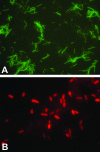Rapid identification of pathogens in blood cultures with a modified fluorescence in situ hybridization assay
- PMID: 17088371
- PMCID: PMC1698318
- DOI: 10.1128/JCM.01085-06
Rapid identification of pathogens in blood cultures with a modified fluorescence in situ hybridization assay
Abstract
We evaluated a modified fluorescence in situ hybridization (FISH) assay for rapid (<1 h) identification of microorganisms in growth-positive blood cultures. The results were compared to those of the standard FISH technique and conventional culturing. The rapid identification of microorganisms with modified FISH can have important effects on clinical management of patients with bloodstream infections.
Figures

References
-
- Durm, M., F. M. Haar, M. Hausmann, M. Ludwig, and C. Cremer. 1997. Optimized Fast-FISH with α-satellite probes: acceleration by microwave activation. Braz. J. Med. Biol. Res. 30:15-23. - PubMed
-
- Frahm, E., I. Heiber, S. Hoffmann, C. Koob, H. Meier, W. Ludwig, et al. 1998. Application of 23S rDNA-targeted oligonucleotide probes specific for enterococci to water hygiene control. Syst. Appl. Microbiol. 21:450-453. - PubMed
-
- Gosálvez, J., J. De la Torre, M. Pita, A. Martinez-Ramirez, C. Lopez-Fernandez, V. Goyanes, and J. Lopez-Fernandez. 2002. FISHing in the microwave: the easy way to preserve proteins. I. Colocalization of DNA probes and surface antigens in human leukocytes. Chromosome Res. 10:137-143. - PubMed
Publication types
MeSH terms
LinkOut - more resources
Full Text Sources
Other Literature Sources
Medical

